Table of Contents
- Introduction to Chemical Blending
- Critical Components of Effective Blending
- Innovations in Chemical Blending Technology
- Safety and Compliance
- Future Trends in Chemical Blending
Introduction to Chemical Blending
Chemical blending is crucial in numerous industries, from pharmaceuticals to manufacturing. By meticulously combining different substances under controlled conditions, blending aims to achieve a homogeneous mixture. Effective chemical blending depends on precise control and accurate measurement of the raw materials, ensuring consistency and the desired quality of the final product. Utilizing advanced chemical mixers can significantly enhance the precision and efficiency of the blending process, making it indispensable for maintaining high production standards.
Various sectors, including food processing, cosmetics, and chemicals, rely heavily on blending to produce consistent, high-quality products. Each industry has unique requirements and standards, but the underlying principles of chemical blending remain universally important. With the advent of modern blending technologies, achieving the desired consistency and efficiency in blending processes has become more attainable than ever before, paving the way for innovations and improvements across different applications.
Critical Components of Effective Blending
Effective chemical blending relies on several core components to create a seamless process. The choice of equipment, such as reactors and mixers, plays a vital role in ensuring the consistency and quality of the blend. Additionally, understanding the chemicals’ properties guarantees optimal results and reduces the risk of errors or adverse reactions.
State-of-the-Art Equipment
Investing in state-of-the-art blending equipment is essential for any industrial application. High-quality mixers and reactors help maintain uniformity and prevent unwanted reactions during blending. Modern equipment often has advanced features such as real-time monitoring and automated control systems, which enhance precision and provide valuable data for optimizing the blending process. Selecting appropriate equipment based on the application’s needs can lead to considerable productivity and product quality improvements.
Understanding Chemical Properties
Different chemicals have unique properties that can significantly affect the blending process. Viscosity, density, and reactivity must be considered when designing a blending protocol. Understanding these properties helps select the right equipment and conditions for blending, ensuring a successful outcome. Moreover, it allows for customizing blending processes to cater to specific requirements, leading to more efficient and effective production.
This article provides more in-depth information on the technical aspects of blending. Discover how advanced mixing techniques improve quality and efficiency.
Innovations in Chemical Blending Technology
The field of chemical blending is continuously evolving with technological advancements. Automated systems and real-time monitoring are game-changers, ensuring precision and consistency in blends. These innovations enhance the efficiency of blending processes and provide valuable data that can be used to optimize performance and quality further.
Automation and AI
Automation and artificial intelligence (AI) are revolutionizing the chemical blending industry. Automated systems can precisely control and monitor the blending process, reducing human error and increasing efficiency. AI algorithms can optimize blending protocols and predict potential issues before they occur, providing a proactive approach to process management. By leveraging automation and AI, industries can achieve higher consistency, quality, and productivity levels in their blending operations.
In this report, you will learn about the cutting-edge innovations driving changes in industrial processes.
Safety and Compliance
Safety is paramount in chemical blending operations. Adhering to industry regulations and following best practices reduces risks and ensures a safe working environment. Proper staff training and routine safety audits are essential to a robust safety framework, providing the knowledge and vigilance to prevent accidents and handle emergencies effectively.
Regulatory Compliance
Compliance with industry standards and regulations is critical for safe chemical blending. Regulations often dictate specific procedures and safety measures that must be followed. Staying updated with the latest regulatory requirements ensures compliance and minimizes legal risks. It also helps maintain a good reputation and build trust with stakeholders, clients, and regulatory bodies.
Training and Audits
Personnel participating in the blending process must attend regular training sessions to maintain safety standards. Thorough training programs should include using safety equipment, emergency response protocols, and safe chemical handling. Safety audits and inspections assist in locating possible risks and guarantee that all safety procedures are being appropriately followed. Conducting these audits regularly fosters a culture of safety and continuous improvement.
Future Trends in Chemical Blending
Looking forward, the future of chemical blending is promising. Trends such as digitalization, increased automation, and a focus on sustainability are set to shape the industry significantly. AI and machine learning integration will keep improving the accuracy and efficiency of blending operations, opening up new possibilities for creativity and advancement.
Chemical blending is evolving due to continuous technological advancements and a growing emphasis on environmental responsibility. Industries that embrace these trends and invest in modernizing their blending operations are likely to reap significant benefits in terms of quality, sustainability, and competitiveness in the global market.

